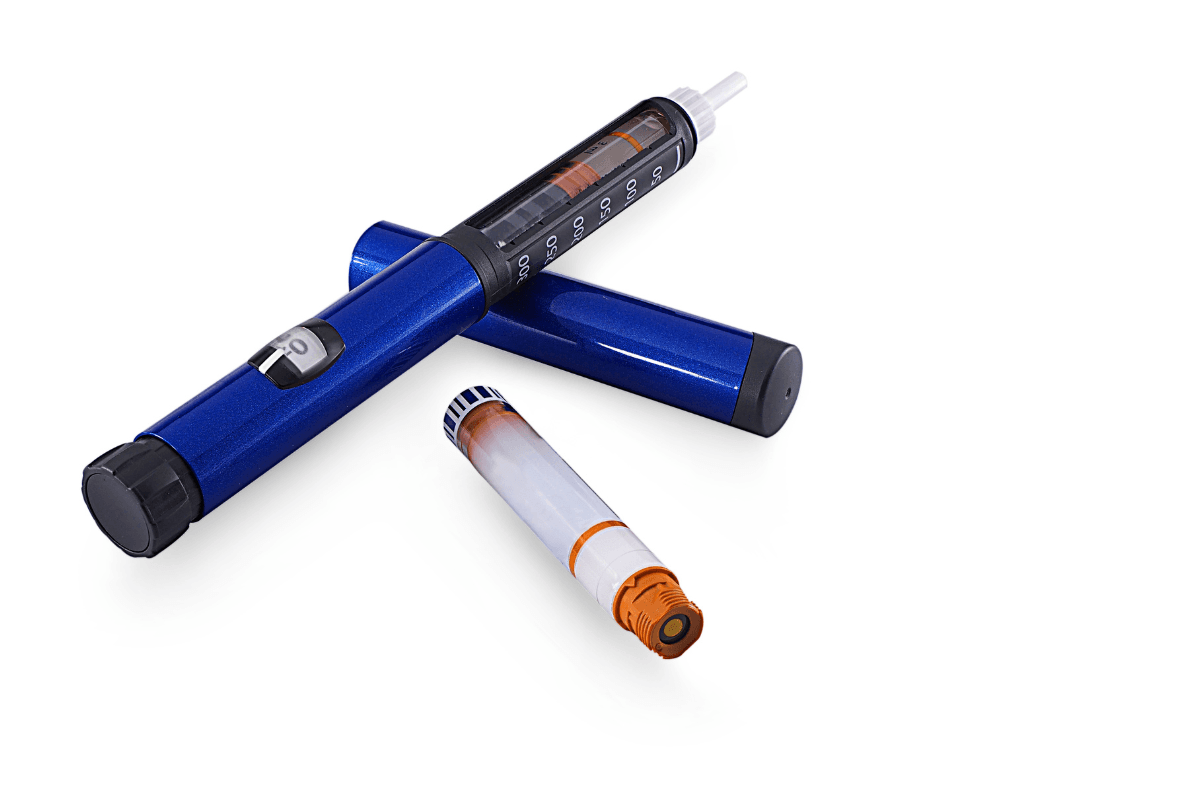Pen therapy has become a practical option for many. This guide explains how insulin cartridges function, which types exist, and when they help. We cover setup, priming, safe changes, and storage. You will see where insulin cartridges fit versus vials and pumps, and how to avoid common errors.
Key Takeaways
- Compact format: Cartridges fit reusable pens for portable dosing.
- Compatibility matters: Match insulin, device model, and cartridge system.
- Prime every time: Air removal helps accurate dosing and flow.
- Storage rules: Protect from heat, light, and freezing to preserve potency.
- Change on time: Replace cartridges and needles using safe disposal.
Understanding Insulin Cartridges
Cartridges are small sealed containers designed to hold insulin for pen devices. Most hold 3 mL of U-100 insulin, which means 300 units per cartridge. Inside, a rubber plunger advances when the pen’s screw mechanism turns. The system aims to deliver consistent unit doses with less preparation than drawing from a vial.
Cartridges pair with either reusable pens or specific disposable pens. Fit and compatibility depend on the pen family and cartridge brand. Some systems follow open formats, while others are proprietary. If you are new to pens, review needle sizing to match your device and skin fold. For needle selection basics, see Insulin Pen Needles for context on lengths and gauges.
Types and Compatibility
Different insulins are filled into tailored cartridges, including rapid-acting, long-acting, and premixed formulations. Cartridges may be glass or plastic and follow specific dimensions that align with the pen’s threading and drive screw. Always confirm the cartridge family, insulin concentration, and lot details before use. This step helps prevent misfits or unexpected resistance during dosing.
Across brands, device ecosystems vary. Rapid options often include aspart or lispro, while long-acting options include glargine and detemir. Premixed products combine basal and bolus components for fixed schedules. For brand-specific performance examples, see Lantus Insulin Cartridge to understand steady basal action, and review Novorapid Cartridge for meal coverage comparisons. If you need a shorter overview, Premixed Insulin summarizes common mixes by ratio. Finally, explore Fiasp Cartridges for faster on-meal timing.
Educational materials often describe the types of insulin pens available to help users choose by regimen and dexterity. Device weight, dose window clarity, and tactile clicks can influence daily use. If a child or visually impaired user needs enhanced feedback, devices with larger dose windows or memory functions may help.
Benefits and Limitations
Cartridges simplify dosing for many people by reducing steps. They may lower handling errors, improve dose tracking, and support discreet use. Compared with vial-and-syringe methods, pen devices often offer clearer unit settings and audible clicks. However, not every person benefits equally; cost, brand restrictions, and hand strength can influence outcomes.
One practical difference relates to unit visibility and calibration. Users sometimes compare insulin pen vs syringe units when switching delivery methods. Pens display pre-set unit increments; syringes rely on barrel markings and manual draws. For a plain-language comparison of formats, see Insulin Pen vs Syringe for pros, cons, and unit-display differences. Authoritative guidance on device selection and safety appears in the NIDDK overview of insulin delivery for context on pens, syringes, and pumps.
How the Mechanism Works
Reusable pens house a drive mechanism that advances a threaded piston. After loading the cartridge, the pen’s screw pushes the internal plunger forward. The needle connects through a hub, and the gate check ensures unidirectional flow. Accurate dosing relies on clean threads, an intact seal, and smooth travel of the plunger. If resistance feels abnormal, pause and check alignment.
Many devices include an insulin pen cartridge holder that locks the cartridge body into the pen. Once the pen cap is removed, the dose dial sets units, and a push button delivers them. For a device-focused view with memory and dosing features, see Novopen 4 for details on accuracy features. Manufacturer instructions typically stress priming, needle changes, and inspection for cracks or cloudiness. For safety fundamentals, review the FDA insulin pen safety page outlining device handling and sharing risks.
Safe Use and Priming
Priming clears air from the system so insulin can flow predictably. Without this step, early clicks may move air rather than medication. That can delay onset or reduce the dose. The volume required for priming varies by pen and needle length, so follow your device’s instructions and clinic guidance carefully.
People often ask what happens if you don’t prime insulin pen. Skipping priming can cause underdosing, bubbles, or stalled flow during delivery. If air persists, repeat the prime or replace the needle. For a walk-through with photos, see How to Use Insulin Pen for a step sequence and common mistakes. You can also consult the FDA insulin pen safety resource for general handling cautions and never-share reminders.
Step-by-Step Use
Most reusable pens follow a similar sequence. Inspect the cartridge for cracks or discoloration, then load and secure it. Attach a new needle, remove both caps, and prime until you see a steady drip. Dial the dose while holding the pen upright, choose your site, and insert at 90 degrees unless advised otherwise. Press and hold the plunger button for several seconds before removing the needle to complete the dose.
If you prefer printed instructions, ask your clinic for a how to use insulin pen step-by-step pdf that matches your pen model. Pen ergonomics differ, so your hold time may vary slightly. For an example of pen ergonomics and dose windows, the Novopen 4 product page offers device specifications for context. Needle comfort also matters; see BD Needles to compare sizes and coatings.
Changing Cartridges, Storage, and Disposal
A planned insulin pen cartridge change helps avoid running empty at inconvenient times. Change the cartridge in good lighting on a clean, dry surface. Inspect the new cartridge. If the insulin appears cloudy when it should be clear, do not use it. Keep a backup needle and alcohol swab available to prevent contamination. After loading, prime again to remove air and verify flow.
Storage affects potency. Protect insulin from direct heat, sunlight, and freezing. Check device-specific temperature ranges before travel. For hazards tied to breaks in storage rules, review Insulin Storage Dangers to see common temperature mistakes, and Expired Insulin for signs of degradation. Dispose of used needles in a puncture-resistant container. For community disposal options, see the CDC guidance on sharps disposal for drop-off sites and mail-back programs.
Choosing a Pen and Cartridge
Start with your insulin regimen, dosing schedule, and any dexterity limits. Individuals using basal-bolus or premix plans may prefer different pens. Those seeking large, clear dose windows might prioritize high-contrast dials. If memory features help adherence, look for pens with dose reminders or last-dose indicators. Consider support resources too, such as training materials from clinics or manufacturers.
Many adults using oral agents eventually add basal insulin. In that context, options like basal cartridges may fit insulin pens for type 2 diabetes regimens. Long-acting options include glargine and detemir, while rapid options cover meals. To compare specific brands, see Basaglar Cartridge for a long-acting profile and the Levemir Penfill Cartridges page for detemir system details. For broader education by condition, browse Type 1 Diabetes and Type 2 Diabetes categories for regimen planning insights.
Tip: Keep the box or insert handy. It lists compatible pens, storage thresholds, and expiration details that you may need later.
Recap
Cartridges offer a compact, consistent way to deliver insulin with reusable pens. Success hinges on correct pairing, careful priming, and mindful storage. Use reliable instructions, replace components on schedule, and verify flow before dosing. When comparing delivery formats, consider dexterity, visibility, and training. Talk with your healthcare team to match devices with your regimen and preferences.
This content is for informational purposes only and is not a substitute for professional medical advice.


